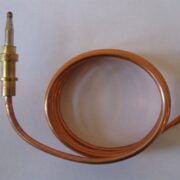Table of Contents
Key Takeaways:
- Thermopiles generate electrical voltage and power when exposed to a temperature gradient.
- Thermopiles are composed of multiple thermocouples connected in series.
- Thermopiles work on the principle of the Seebeck effect.
- Thermopiles are capable of generating electricity from waste heat sources.
- Thermopiles differ from thermocouples as they are primarily used for power generation.
- Thermopiles are used in home heating systems, gas stoves, and industrial temperature measurement.
- Infrared thermopiles detect heat radiation and can be used in medical diagnostics.
- Infrared thermopiles have witnessed advancements in MEMS technology and signal processing algorithms.
- Thermopiles have potential applications in renewable energy generation, miniaturized electronics, and space exploration.
1. Understanding the Basics of Thermopiles
Thermopiles are electronic devices that generate electrical voltage and power when exposed to a temperature gradient. They are composed of multiple thermocouples connected in series, forming a chain of conduction pathways made of different materials. The principle behind thermopiles is based on the Seebeck effect, discovered by Thomas Johann Seebeck in 1821. According to this effect, when two different metals or materials are exposed to a temperature difference, a voltage is generated across the junction. This voltage is proportional to the temperature difference.
The Principle behind Thermopiles
In a thermopile, each thermocouple consists of two dissimilar metal wires or semiconductors joined together at two junctions. These junctions are exposed to different temperatures. The difference in temperature between the hot and cold junctions creates a voltage potential across each thermocouple. When multiple thermocouples are connected in series, their individual voltages add up, resulting in a higher output voltage.
Thermopiles work on the principle that the temperature difference between two junctions of a thermocouple generates a voltage. This voltage is independent of the absolute temperature but is directly proportional to the temperature difference. Therefore, by exposing one end of the thermopile to a heat source and the other end to a cooler surface, a temperature gradient is created, leading to the generation of electricity.
How Thermopiles Generate Electricity
When one end of the thermopile is subjected to a heat source, the temperature at that end increases, while the other end remains relatively cooler. This temperature difference creates a voltage across each thermocouple, and the voltages add up due to their series connection.
The generated voltage can be measured using a voltmeter or used to power electrical devices. The magnitude of the voltage generated depends on factors such as the number of thermocouples in the thermopile, the nature of the materials used, and the temperature difference between the hot and cold junctions.
Thermopiles are capable of generating relatively low power compared to other energy conversion technologies. However, their advantage lies in their ability to generate energy from heat sources that are otherwise wasted or untapped, making them suitable for a wide range of applications.
Thermopile vs Thermocouple: What’s the Difference?
Although thermopiles and thermocouples both rely on the Seebeck effect, they serve different purposes. A thermocouple is a simple device consisting of two dissimilar metal wires connected at one junction known as the measuring junction. The other ends of the wires are connected to a temperature measurement device or controller. The voltage generated by the thermocouple is used for temperature sensing and monitoring.
In contrast, a thermopile consists of multiple thermocouples connected in series, allowing for the generation of a higher output voltage. Thermopiles are primarily used for power generation rather than temperature measurement. They are commonly found in applications that require harvesting waste heat or converting thermal energy into electrical energy.
2. Exploring Thermopile Applications in Everyday Life
Thermopiles have found numerous applications in our everyday lives, improving efficiency, safety, and convenience in various devices and systems. Let’s explore some of the most common applications:
Thermopiles in Home Heating Systems
Thermopiles play a vital role in home heating systems, such as furnaces and boilers. In these systems, a thermopile is placed in the pilot light assembly, which provides a continuous source of heat. The thermopile generates electricity from the heat of the pilot flame and powers the gas valve, ensuring a steady supply of fuel to the main burner. This mechanism not only provides convenience but also enhances the safety of the heating system by automatically shutting off the gas supply if the pilot flame goes out.
By utilizing the waste heat from the pilot flame, thermopiles contribute to the overall energy efficiency of the heating system. They eliminate the need for external power sources or batteries, making the system self-powered and reliable.
Thermopiles in Gas Stoves: A Safer Cooking Option
In gas stoves, thermopiles are used as a safety feature in the gas valve assembly. Similar to home heating systems, thermopiles in gas stoves generate electricity from the heat of the pilot flame. This electrical energy is used to keep the gas valve open, allowing the flow of gas to the burner. If the pilot flame goes out, the thermopile stops generating electricity, causing the gas valve to close automatically. This prevents the buildup of unburned gas and potential fire hazards.
Thermopiles have greatly improved the safety of gas stoves, providing peace of mind to users and reducing the risk of gas leaks and accidental fires. They are widely used in residential kitchens, commercial restaurants, and outdoor cooking appliances.
The Role of Thermopiles in Industrial Temperature Measurement
Thermopiles are extensively utilized in industrial temperature measurement applications, where accurate and reliable measurement is critical. Infrared thermometers, also known as non-contact temperature sensors, rely on the principles of thermopiles for temperature detection.
Infrared thermopiles consist of an array of thermocouples that detect the infrared radiation emitted by an object. The temperature difference between the object and the thermopile generates a voltage output, which is converted into temperature readings. This technology is commonly used in industries such as manufacturing, automotive, and food processing, where contact-based temperature measurement methods may be impractical or unsafe.
Thermopiles offer advantages such as fast response time, non-contact measurement capability, and wide temperature range. They have become an essential tool for industrial processes that require accurate temperature monitoring for quality control, equipment maintenance, and energy efficiency. Get insight into how electronic devices are used and deliver assistance to users by visiting clipchamp.org.
3. Unveiling the Intricate Working of Infrared Thermopiles
Infrared thermopiles, also referred to as infrared sensors or detectors, have revolutionized various fields, including medicine, security, and energy. Understanding their intricate working is key to unlocking their vast potential and applications.
How Infrared Thermopiles Detect Heat Radiation
Infrared thermopiles work based on the principle of converting heat radiation into electrical energy. This is achieved through the use of specialized materials and the arrangement of thermocouples.
When an object radiates heat energy in the form of infrared radiation, it interacts with the thermopile’s components. Infrared radiation consists of photons with different energy levels. The photons strike the thermopile’s surface, causing the temperature of the surface to increase. This increase in temperature creates a temperature gradient across the thermocouples, generating a voltage output. The magnitude of the voltage is directly proportional to the intensity of the heat radiation.
By measuring this voltage output, infrared thermopiles can accurately determine the temperature of the object emitting the heat radiation. This allows them to be used in a wide range of applications, including temperature monitoring, thermal imaging, and motion detection.
Advancements in Infrared Thermopile Technology
The field of infrared thermopiles has witnessed significant advancements in recent years, leading to improved performance and expanded applications. One notable advancement is the development of microelectromechanical systems (MEMS) technology, which has enabled the miniaturization of infrared thermopile sensors.
MEMS-based infrared thermopiles offer several advantages over traditional sensors, including reduced size, lower cost, and higher sensitivity. These advancements have made infrared thermopiles more accessible and suitable for integration into various consumer electronics, such as smartphones, smartwatches, and home security systems.
Furthermore, the integration of signal processing algorithms and artificial intelligence has enhanced the capabilities of infrared thermopiles, allowing for better image quality, object recognition, and analysis. This has opened up new possibilities in fields such as biomedical imaging, night vision, and autonomous vehicles.
Applications of Infrared Thermopiles in Medical Diagnostics
Infrared thermopiles have found valuable applications in medical diagnostics, particularly in the field of contactless temperature measurement. They provide a safe and non-invasive method for monitoring patient temperature, eliminating the need for physical contact with thermometers.
These thermopiles can be integrated into wearable devices, fever screening systems, and medical imaging devices to provide real-time temperature monitoring. Infrared thermopiles enable continuous temperature measurement without disturbing the patient, making them ideal for monitoring critically ill individuals, infants, or individuals with sensitive skin.
In addition to temperature measurement, infrared thermopiles are also used in medical imaging techniques such as infrared spectroscopy and thermography. These techniques allow for the detection and analysis of anomalies in the body, assisting in the diagnosis and treatment of various medical conditions.
4. The Future of Thermopile Technology: Exciting Innovations
As thermopile technology continues to advance, exciting innovations are on the horizon, promising new possibilities and applications.
Thermopiles in Renewable Energy Generation
One of the most promising areas of development for thermopiles is in renewable energy generation. Thermopiles have the potential to harness waste heat from various sources, including industrial processes, power plants, and even everyday appliances.
By converting waste heat into electricity, thermopiles can improve overall energy efficiency and reduce carbon emissions. These devices can be integrated into systems like geothermal power plants, solar thermal systems, and waste heat recovery units to maximize energy utilization and reduce dependency on fossil fuels.
Miniaturized Thermopiles: The Next Frontier in Electronics
Miniaturization is a significant trend in the electronics industry, with a growing demand for smaller and more efficient devices. Thermopiles are no exception to this trend.
Advancements in microfabrication techniques and material science have made it possible to develop miniaturized thermopiles with high performance and low power consumption. These miniature thermopiles can be integrated into electronic devices such as wearable technology, Internet of Things (IoT) devices, and implantable medical devices.
The ability to harvest energy from body heat or ambient temperature fluctuations opens up new opportunities for creating self-powered electronic devices with extended battery life or even battery-free operation.
Exploring the Potential of Thermopiles in Space Exploration
Thermopiles have shown great potential for use in space exploration missions, where the availability of energy is crucial. The ability to convert waste heat into electricity can significantly enhance the longevity and capabilities of space probes, rovers, and satellites.
In space, waste heat is abundant from various sources, including the sun’s radiation, electronic components, and the natural decay of radioactive materials. Thermopiles can efficiently capture and convert this waste heat into usable electrical energy, reducing the reliance on limited onboard power supplies and enabling longer and more ambitious missions.
Furthermore, the compact size and self-sustainability of thermopiles make them an attractive option for powering spacecraft systems and instruments without the need for bulky solar panels or fuel cells.
In conclusion, thermopiles are versatile devices that generate electricity from temperature differences. They find applications in numerous fields, including home heating systems, gas stoves, industrial temperature measurement, infrared thermopiles, and medical diagnostics.
The future of thermopile technology holds exciting innovations, such as their integration into renewable energy generation systems, miniaturization for use in electronic devices, and their potential use in space exploration missions. With continued advancements, thermopiles have the potential to transform the way we generate and utilize energy in various applications.











Comments